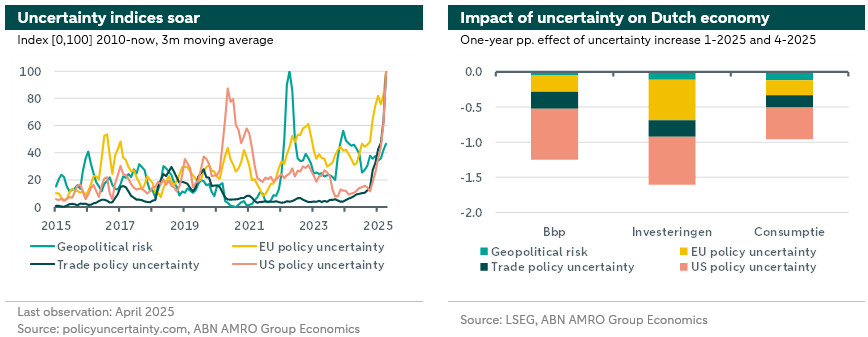NL Update – The Netherlands also imports negative effects of international uncertainty

The trade war, US import tariffs and geopolitical risk cast a shadow over economic expectations. Uncertainty about major policy changes negatively affects the economy even without actual changes. This uncertainty likely causes Dutch companies to invest less and households to save more, at the expense of consumption. This while the savings rate was already elevated. The Dutch economy is more affected by US policy uncertainty than the broader eurozone. However, policy uncertainty from the EU also negatively affects domestic demand.
Only the risk of policy changes already has an impact on the economy
As we described in a previous publication, the world faces historical uncertainty. Under normal circumstances, it is difficult for businesses and households to look ahead. Current geopolitical uncertainty makes this even more difficult, if not impossible. This uncertainty and the risk of policy changes alone already has an impact on the economy, even without actual changes, such as import tariffs. For instance, uncertainty can cause companies to wait to invest and can incentivize households to save more, at the expense of consumption.
We review four uncertainty indices from the academic literature, created based on text analysis* . The left graph below shows the indices. They are normalised, making 0 the lowest and 100 the highest value since 2010. The series do not reflect an absolute amount of risk, so they are not comparable between each other, only over time with their own series.
* US and EU policy uncertainty indices are from Baker, Bloom and Davis (2016). Geopolitical risk comes from Caldara and Iacoviello (2021) and trade policy uncertainty comes from Caldara, Iacoviello, Molligo, Prestipino and Raffo (2020).
Uncertainty is dominant
Trade policy uncertainty has obviously risen sharply since President Trump's election. That uncertainty is more than three times higher than during his first presidency. The main factor contributing to the increased uncertainty comes from the constantly changing US trade policy. Import tariffs are, despite the recent rollback of parts of policy, at record levels. Policies can be rolled back which reduces the immediate impact, but it does not remove uncertainty. On top of this, overall policy uncertainty within the US has increased since Trump's election, for instance due to the various plans around tax changes. In the EU, policy uncertainty has also increased to unprecedented levels. Elections in many different member states, the European Commission's plan to simplify regulations and discussions on (common) defence spending and other budgetary issues – mostly due to the changing relationship with the US – have made the European policy stance more uncertain. Finally, geopolitical risk did not increase further after the Russian invasion of Ukraine, but is still higher than halfway through last year.
In this publication, we quantify the potential macroeconomic impact of the increase in uncertainty for the Netherlands**.
** The analysis is based on impulse response functions of a large quarterly Bayesian VAR that models the impact of uncertainty on macro outcomes, controlling for one year of macro history.

Dutch economy hit by international uncertainty
In the right-hand chart above, we look at the impact of the four different forms of uncertainty on the Dutch economy. These calculations are based on the increase in uncertainty between January and April 2025. The figure show the one-year percentage point effect of this uncertainty. This means that the increase in uncertainty in the months under review could have a cumulative impact on GDP throughout a year; mainly due to a fall in investment. For instance, uncertainty in the international playing field seemed to seep into the economy in the first-quarter figures.
Earlier, we looked at the impact of uncertainty on the eurozone. Zooming in on the impact on the Netherlands, we see that uncertainty has the biggest impact on investment, although the overall impact is slightly smaller than that of the broader eurozone. In addition, Dutch firms seem to look relatively more to policy uncertainty in the US for their investment decisions than firms in the eurozone. The same goes for policy uncertainty in the EU. As a trade-oriented country, the Netherlands is obviously heavily influenced by international developments, which may explain the difference between the Netherlands and the broader eurozone. For instance, the Dutch economy is more affected by geopolitical risks.
Dutch consumers are also affected by uncertainty. Mainly due to policy uncertainty in the US, possibly due to Dutch consumers' high exposure to US news. Compared to the eurozone, Dutch consumers also care more about policy uncertainty in the EU and geopolitical risk. The average household in the Netherlands thus seems to have its eyes on the outside world. Even before the increase in high uncertainty, the savings rate of households in the Netherlands was higher than before the pandemic.
Domestic policy uncertainty also depresses activity
Although there is no series for Dutch policy uncertainty, it could also affect the Dutch economy. The lack of a short-term solution for a number of pressing dossiers, such as nitrogen, the electricity grid and the housing market, also creates uncertainty. For some of these dossiers, the decision was taken to postpone decisions to Budget Day (or ‘Prinsjesdag’). This too contributes to uncertainty, thus adding to the negative effects of uncertainty on economic activity.
Dutch economy can take a beating
Besides the direct impact of tariffs on trade with the US and world trade, uncertainty also affects Dutch activity. Therefore, in addition to the direct and indirect impact of the tariffs, we also include the impact of uncertainty in our forecasts. In the current economic climate, one relevant factor is that the Dutch economy can take a beating, as its fundamentals are strong. Think of a tight labour market and the recovery of household purchasing power. Despite the effects of uncertainty, we still expect that economic growth next year will be driven by domestic demand.

